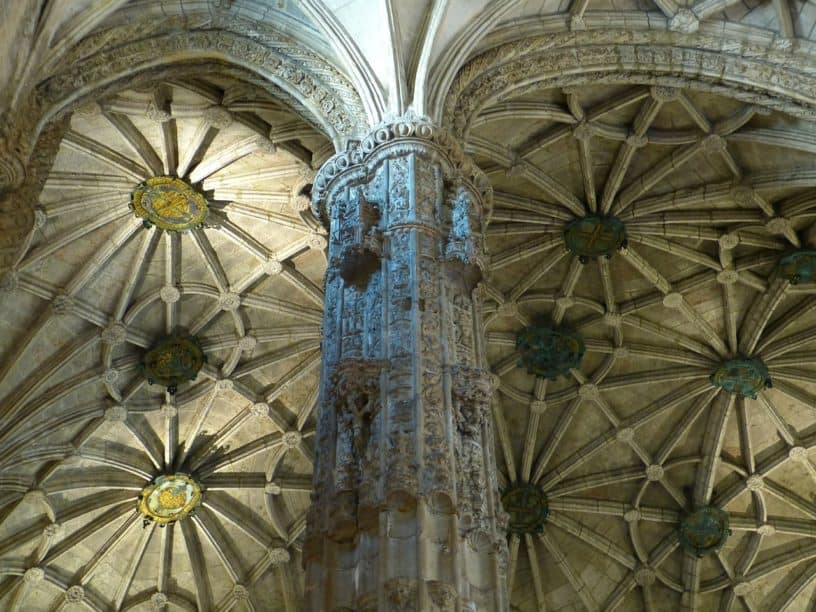A quick guide to Lisbon’s architecture
As you walk through the city of Lisbon, you will see that it has an incredible variety of architecture styles scattered around the city. Despite the fact that most of the city was damaged by the 1755 earthquake, Lisbon still escaped from the bombings of the Second World War, which is why it is now possible to see architecture styles from many different periods of history.
The Pombaline and Manueline architecture styles are the most highlighted ones throughout the city, as well as the rich Baroque interiors!
Architecture is essential to all societies around the world. It enables the harmonious integration of humans creations to the environment, supporting health and well-being, aesthetically enriching lives and allowing the economic growth and creating a legacy that reflects and symbolizes the cultures and traditions.
Althroughout the centuries, humans have built houses and buildings with the purpose to image their ideals and ambitions. When one digs into the architecture of a new city, they get to learn a lot more than expected. Because the architecture is one of the greatest fields for people to explore if they want to learn and understand a city’s history, culture, and customs. This is why I’ve decided to write a quick guide to Lisbon’s architecture! I will introduce you to the many styles you will find in this amazing city, enabling you to know what to look for and where to go! Read on and enjoy!
Manueline
The Age of Discoveries brought great wealth and knowledge to Portugal. During this period, the Portuguese explorers and navigators introduced the world to distant civilizations and many foreign artists came to work in Portugal. The Manueline architecture style was born from this cultural encounter, which is a specific interpretation of the Gothic in terms of architectural structure and decoration.
As you walk through the city of Lisbon and have a look at the Manueline monuments, you will be able to identify different ornaments and symbols that are only found in Portugal, such as maritime themes, the national crest, the king’s seal, and crosses. This architectural style appeared during the reign of the King Manuel I, that inspired the name of the Manueline architecture.
In Lisbon, the most emblematic monuments of the Manueline architecture are found in Belém. They obviously are the Mosteiro dos Jerónimos and the Torre de Belém, but there are also other examples found around the city, like the Museu do Azulejo (National Tile Museum), the Igreja da Conceição Velha and the Casa dos Bicos.
If you travel through Portugal, keep your eyes open! Sometimes a portal, twinned windows, a little church and other details that are found in the oldest buildings scattered around the country will allow you to discover and learn more about the creative genius of the Manueline architecture.
Gothic
In Lisbon, you will only find a few Gothic monuments. The most outstanding examples is the Convento do Carmo which was heavily damaged by the 1755 earthquake. The monks could not afford the cost for its reconstruction, so the roof never was repaired. But it turned out to be one of the most beautiful ruins you’ll see!
Another Gothic building in the city of Lisbon is the Sé de Lisboa. Built during the twelth century, it is one of the oldest monuments of the city. Over the years, it went through many interventions and Baroque and Neo-classic details were added. The entrance is free, so you have no excuses not to visit this stunning church. You will only have to pay if you want to access to the treasure and the cloister.
Pombaline
After the 1755 earthquake, the city of Lisbon was reconstructed with an architecture style known as “Pombaline“, which was named after the responsible of the project of reconstruction of the city, the Marquis of Pombal.
This architecture style is very simple, with uncluttered façades or tile-covered ones, anti-seismic structures and four-storey buildings. This project was considered to be avant-garde for the time. It was the first example of urbanism.

© Toponímia de Lisboa
In Lisbon, you will find Pombaline buildings in the Baixa neighborhood and Rossio. These areas are perfect for afternoon walks on a sunny day, espcially the Baixa! Also, if you want to have a look at Neo-classic buildings in Lisbon, the most perfect examples are the Teatro São Carlos around Chiado, the Palácio da Bemposta and the Palácio da Ajuda.
Baroque

© Joaquim T (Lonely Planet)
The Baroque architecture style appeared from the discovery of gold and diamonds in Brazil during the eighteenth century. This lead to the proliferation of golden decorations in many churches and palaces in Portugal and throughout Europe.
You won’t find a lot of totally Baroque monuments in Lisbon, because this style was mostly used for the enrichment of buildings that already existed. So the Baroque style was usually mixed with other styles in reconstructions and renovations.
If you want to see the Baroque architecute style while in Lisbon, visit the interiors of the following monuments: the Igreja São Roque in Bairro Alto neighborhood, the Igreja de Santa Catarina, the Igreja do Menino de Deus in the Alfama neighnborhood, and the National Pantheon.
Moorish

© Tiago Pereira Santos (Círculo da Inovação)
The Castelo São Jorge is the only monument from the Moors period in Lisbon. However, during the nineteenth century, many new constructions were inspired by the Moors period. For instance, the Praça de Touros in Campo Pequeno and the Casa do Alentejo as well, among many others that are scattered around the city!
If you want to see more Moorish monuments in Portugal, I recommend you to visit the Palácio Nacional of Sintra, the Castelo dos Mouros that is also in Sintra!
While in Lisbon, you will find plenty of different architecture styles: from those I’ve mentioned to Art Nouveau and more contemporary buildings, Lisbon has so much to offer to the travelers among you that enjoy architecture! If you enjoy discovering a new city and its history through the study of the architecture of its buildings, you will love walking in Lisbon while exploring and getting to know all these different architecture styles! I hope you’ve enjoyed this quick guide to Lisbon’s architecture! Now that you’ve been introduced to its many architecture styles, you just need to roam around the city aimlessly and explore all its secret places. If you want to discover the city in the company of a local, join one of our walking tours! Don’t hesitate to contact us, if you need further information about anything! See you soon in Lisbon!
Planning a trip to Paris ? Get ready !
These are Amazon’s best-selling travel products that you may need for coming to Paris.
Bookstore
- The best travel book : Rick Steves – Paris 2023 – Learn more here
- Fodor’s Paris 2024 – Learn more here
Travel Gear
- Venture Pal Lightweight Backpack – Learn more here
- Samsonite Winfield 2 28″ Luggage – Learn more here
- Swig Savvy’s Stainless Steel Insulated Water Bottle – Learn more here
Check Amazon’s best-seller list for the most popular travel accessories. We sometimes read this list just to find out what new travel products people are buying.















